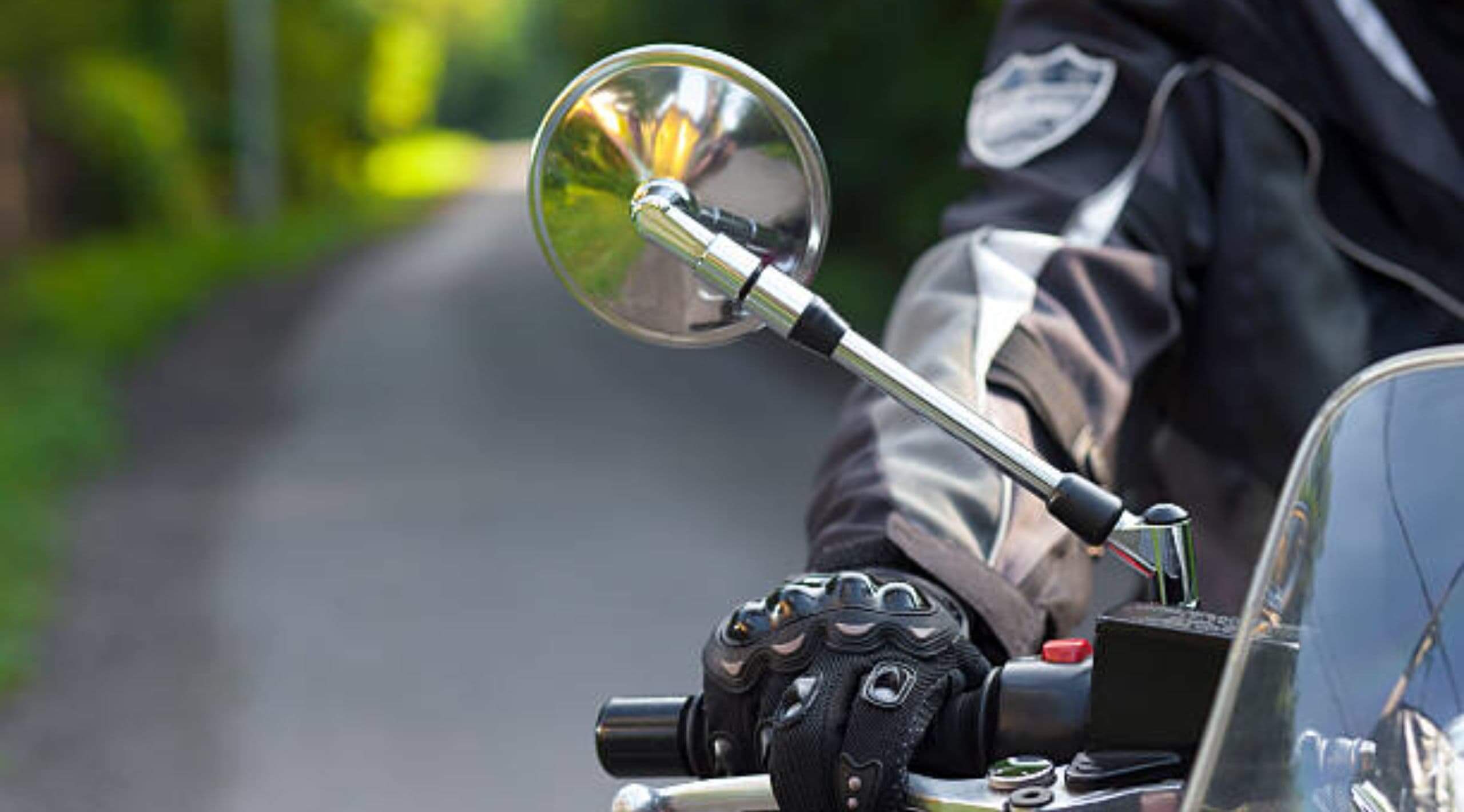Why Are Mirrors Important for Motorcycle Safety?
Mirrors are indispensable tools for motorcycle safety. They act as the eyes at the back of a rider’s head, offering a panoramic view of what’s happening behind. In bustling states like California and Texas, where lane-splitting is a common practice, the importance of mirrors is magnified. Lane-splitting, while efficient, can be hazardous if riders aren’t fully aware of their surroundings. Mirrors bridge this gap, reducing the chances of collisions by offering a clear view of vehicles approaching from behind.
Furthermore, blind spots are a significant concern for all vehicles, but for motorcycles, they can be deadly. Mirrors help in mitigating these blind spots, ensuring riders have a 360-degree view of their environment. This comprehensive view is especially vital when executing maneuvers like lane changes or overtaking. Moreover, in adverse weather conditions such as rain, fog, or even heavy dust, visibility drops significantly. Mirrors, in such scenarios, become the first line of defense, helping riders gauge the proximity, speed, and intentions of vehicles behind them, ensuring they make safe riding decisions.
Understanding the Legal Requirements for Motorcycle Mirrors
Motorcycle laws, especially those concerning mirrors, are crafted with safety at their core. Across the vast expanse of the United States, these laws exhibit variations. For instance, while Arizona, Virginia, and Nevada might have certain stipulations, Maryland’s requirements might differ slightly. The common thread, however, is the emphasis on safety. The Department of Motor Vehicles (DMV) in numerous states has clear guidelines on mirror specifications.
In some states, the law might dictate the size, shape, or even the reflective quality of the mirror. The primary objective is to ensure that the mirrors provide an unobstructed and clear view of the road behind. Non-compliance with these laws not only leads to legal repercussions but also compromises safety. For riders crossing state lines, it’s crucial to be aware of these varying requirements. This knowledge ensures they remain on the right side of the law and prioritize their safety and that of other road users.
The Role of Mirrors in Enhancing Rider Awareness on the Road
While mirrors are essential for legal compliance, their role transcends legal boundaries. They are instrumental in heightening rider awareness. A well-placed and clear mirror can provide insights into the road’s dynamics, from understanding an at-fault driver’s intentions to spotting a police officer signaling from a distance.
This enhanced awareness is not just about safety; it’s about empowering riders with information. With the right information, riders can make split-second decisions, significantly reducing their reaction time. This rapid decision-making capability can be the difference between a safe ride and a potential mishap. For instance, if a motorcyclist spots an erratic driver through the mirror, they can take preemptive action, like changing lanes or slowing down. Similarly, in congested traffic scenarios, mirrors provide a broader view, helping riders navigate safely. In essence, mirrors act as a continuous feed of information, ensuring riders are always in the know, making the roads safer for everyone.
Debunking Common Myths About Motorcycle Mirrors
Motorcycle mirrors, despite their evident importance, are often surrounded by myths and misconceptions. One prevalent myth is that due to the compact nature of motorcycles, mirrors are redundant. This belief is rooted in the idea that the rider’s peripheral vision and the ability to turn their head quickly negates the need for mirrors. Another common misconception is that merely turning one’s head provides a comprehensive view of the surroundings. However, this action can momentarily divert a rider’s attention from the road ahead, leading to potential hazards.
The National Highway Traffic Safety Administration (NHTSA) has consistently emphasized the importance of motorcycle mirrors. Their data reveals a compelling narrative: proper utilization of mirrors can drastically reduce accidents. Mirrors provide a continuous, real-time feed of the environment behind the rider, ensuring they remain aware without significant head movements, which can be distracting and risky, especially at high speeds.
The Benefits of Having Mirrors on a Motorcycle
Mirrors on a motorcycle serve a purpose far beyond legal compliance. At the heart of their design and function is the rider’s safety and enhanced visibility. On bustling roads, numerous potential hazards can arise, from an overtaking vehicle to unexpected road debris or even animals crossing the road. Mirrors provide riders with the crucial seconds needed to react appropriately to these potential threats.
Additionally, mirrors play a pivotal role in assessing weather conditions. On days with heavy fog or rain, the rearview can help gauge the visibility levels behind the motorcycle, allowing riders to adjust their speed and riding style. For instance, if a rider observes vehicles behind them struggling with visibility, they might choose to increase their following distance or find a safe spot to pull over until conditions improve. In essence, mirrors act as an additional set of eyes, constantly feeding information to the rider, ensuring they remain safe and make informed decisions on the move.
Exploring Safety Risks of Riding without Motorcycle Mirrors
Choosing to ride without mirrors is akin to venturing into the unknown. Without them, riders are essentially blind to a significant portion of their surroundings. This blindness is not just a metaphorical concept but a tangible risk that can lead to severe consequences on the road.
States like Tennessee and Mississippi, known for their unpredictable traffic patterns, amplify the risks associated with riding mirrorless. A sudden lane change by a vehicle, an aggressive driver trying to overtake, or even a pedestrian attempting to cross the road can catch a rider off guard.
Furthermore, the absence of mirrors can lead to missed signals from law enforcement officers, potentially resulting in legal ramifications. But more critically, not spotting an at-fault driver approaching rapidly from behind can lead to dangerous collisions. In high-speed scenarios, these collisions can be catastrophic.
In conclusion, while mirrors might seem like simple accessories, their absence can compromise the safety of the rider and others on the road. Riding without them is a gamble that no rider should take.
Legal Implications: Do You Need Mirrors to Meet Requirements?
The legal landscape surrounding motorcycle mirrors is clear in its intent, if varied in its specifics: safety is paramount. In the vast majority of states across the United States, having mirrors on your motorcycle isn’t just a recommendation; it’s a legal necessity. The rationale behind this is straightforward. Mirrors provide riders with a broader perspective of their surroundings, reducing the risk of accidents caused by blind spots or sudden maneuvers by other vehicles.
However, the consequences of not adhering to these requirements can be severe. Depending on the jurisdiction, riders caught without the mandated mirrors might face hefty fines. In more stringent states, repeated offenses could even lead to the suspension or revocation of the motorcycle license. Beyond the immediate financial or legal repercussions, riding without mirrors can also have implications for insurance claims in the event of an accident. In essence, while the specifics of mirror requirements might differ from one state to another, the universal message is clear: mirrors are essential for safety and legal compliance.
Choosing the Right Mirrors to Ensure Safety and Compliance
The market is flooded with a plethora of motorcycle mirror designs, from sleek, aerodynamic models to more classic, retro styles. (Recommend: Top 10 Best Motorcycle Mirrors for 2023) However, when choosing mirrors, riders must prioritize function over form. The primary purpose of a mirror is to provide a clear, unobstructed view of the road behind. Any design that compromises this clarity is a potential safety hazard.
Different states might have specific criteria that mirrors must meet. Some might stipulate a minimum diameter to ensure a broad field of view. Others might have requirements regarding the mirror’s positioning or the materials from which it’s made. Before investing in mirrors, it’s prudent to consult with the local Department of Motor Vehicles (DMV) or delve into the motorcycle laws specific to your state. This research ensures that your chosen mirrors not only enhance your safety but also keep you compliant with local regulations.
How Many Mirrors Does a Motorcycle Need?
The question of how many mirrors a motorcycle should have isn’t one with a universal answer. The requirements vary based on state laws. Some states, prioritizing a comprehensive field of view, mandate that motorcycles be equipped with two mirrors – one on each handlebar. This ensures that riders can monitor both the left and right sides of their vehicle without significant head movement.
However, other states might be more lenient, requiring only a single mirror, usually on the left side. The rationale is that a single mirror when properly adjusted, can provide a sufficient view of the road behind. Regardless of the specific number, the underlying principle remains consistent: mirrors are crucial for safety. As such, riders should always familiarize themselves with the motorcycle laws in their state of residence or any state they plan to traverse. This knowledge ensures not only legal compliance but also a safer riding experience.
Proper Placement and Adjustment of Motorcycle Mirrors
The placement and adjustment of motorcycle mirrors are not mere details; they are vital aspects of road safety. Mirrors should be positioned to offer a clear and comprehensive view of the road behind them. This means that they should be adjusted so that the rider can see beyond their own body and the motorcycle itself, capturing the entire roadway. If improperly adjusted, mirrors might only reflect the rider’s elbows or other parts of the motorcycle, rendering them useless.
Regular checks and adjustments are necessary to maintain this optimal positioning. Vibrations during a ride, accidental bumps, or even changes in weather conditions can alter the mirrors’ alignment. Especially after long road trips or riding on rough terrains, a quick check and adjustment can make all the difference in safety. Proper placement and regular maintenance of mirrors are not just about compliance with motorcycle laws; they are fundamental to safe riding.
Tips for Maintaining and Regularly Checking Motorcycle Mirrors
Like any other vital part of a motorcycle, mirrors require regular maintenance and care. Keeping them clean ensures that they provide a clear view of the road. Dirt, dust, or water spots can obscure the reflection, leading to potential blind spots.
Additionally, mirrors should be regularly inspected for cracks or other damages. Even a small crack can distort the reflection, misleading the rider about distances or the position of other vehicles. Ensuring that the mirrors are securely fastened is equally important. Loose mirrors can shift during a ride, suddenly leaving the rider without a clear view of what’s behind them. (Quick Fix: How to Tighten Motorcycle Mirrors)
Given the critical role that mirrors play in ensuring safety on the road, it’s wise to make a habit of checking them before every ride. A few moments spent inspecting and adjusting the mirrors can prevent accidents and contribute to a more enjoyable riding experience.
Sum Up
Mirrors are far more than mere accessories on a motorcycle. They are essential tools that enhance safety, awareness, and legal compliance. From the bustling roads of California to the scenic routes of Virginia, the importance of mirrors remains constant. They provide riders with the vital information needed to make split-second decisions, navigate traffic, and respond to unexpected situations.
Ensuring that a motorcycle is equipped with the necessary mirrors, properly placed and well-maintained, is both a legal mandate and a proactive safety measure. It reflects a rider’s commitment to not only their own well-being but also the safety of others on the road. In the dynamic and often unpredictable world of road travel, being proactive with safety measures like mirrors is always the best choice. It’s not just about following the rules; it’s about embracing a culture of safety and responsibility.

